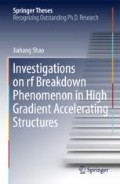Abstract
Field emission from a solid metal surface, the precursor of rf breakdown, has been continuously studied for a century from macroscopic to atomic scales. However, many fundamental questions are yet to be answered, especially in rf case. Uncontrollable field emission position is one of the main barriers on the path to explore its nature. This chapter introduces a novel method to control the location of field emission and that of rf breakdown with a pin cathode. The study has been conducted on an L-band single-cell photocathode rf gun at the Argonne Wakefield Accelerator facility. The first part is to study the evolution of field emission during the rf conditioning period. The experimental results suggest there is an rf breakdown threshold of the maximum electric field on copper surface. The second part is to examine the localized field emission dependence on global parameters. The stored energy of the rf gun was changed by adjusting the longitudinal position (distance between the cathode base and the gun back surface) of the cathode while the applied electric field on the cathode tip was kept constant. A strong dependence of field emission on the stored energy has been observed which implies that under certain circumstances, a localized field emission may be significantly altered by the global parameters in a system.
Access this chapter
Tax calculation will be finalised at checkout
Purchases are for personal use only
References
Ho C, Yang T, Hwang J et al (1998) SRRC/ANL high current L-band single cell photocathode rf gun. In Proceedings of EPAC1998, Stockholm, Sweden
Billen J, Young L (1996) Poisson Superfish. Technical report LA-UR-96-1834, Los Alamos National Laboratory
Ko K, Candel A, Ge L et al (2010) Advances in parallel electromagnetic codes for accelerator science and development. In Proceedings of LINAC2010, Tsukuba, Japan
Wang JW, Loew GA (1997) Field emission and rf breakdown in high-gradient room-temperature linac structures. Technical report SLAC-PUB-7684, SLAC
Degiovanni A, Wuensch W, Navarro J (2016) Comparison of the conditioning of high gradient accelerating structures. Phys Rev Accel Beams 19:032001
Wiener J, Padamsee H (2008) Improvements in field emission: An updated statistical model for electropolished baked cavities. Technical report TESLA 2008-02, DESY
Levinsen Y, Descoeudres A, Calatroni S et al (2009) Statistical modeling of dc sparks. In Proceedings of PAC09, Vancouver, Canada
Descoeudres A, Levinsen Y, Calatroni S et al (2009) Investigation of the dc vacuum breakdown mechanism. Phys Rev ST Accel Beams 12:092001
Descoeudres A, Ramsvik T, Calatroni S et al (2009) dc breakdown conditioning and breakdown rate of metals and metallic alloys under ultrahigh vacuum. Phys Rev ST Accel Beams 12:032001
Timko H, Aicheler M, Alknes P et al (2011) Energy dependence of processing and breakdown properties of Cu and Mo. Phys Rev ST Accel Beams 14:101003
Dolgashev V (2013) Recent high gradient tests at SLAC. In Proceedings of HG2013, ICTP Trieste, Italy
Zha H (2013) Design and experiment of CLIC choke-mode accelerating structure. Ph.D. thesis, Tsinghua University
Timko H, Matyash K, Schneider R et al (2011) A one-dimensional particle-in-cell model of plasma build-up in vacuum arcs. Contrib Plasma Phys 51:1
Wang F (2015) The macroscopic field emission. In Proceedings of HG2015, Beijing, China
Hatch A, Williams H (1958) Multipacting modes of high-frequency gaseous breakdown. Phys Rev 112:681–685
Vaughan J, Trans IEEE (1988) Multipactor. Electron Devices 35:1172–1180
Gilardini A (1995) Multipacting discharges: Constant-k theory and simulation results. J Appl Phys 78:783–795
Han J, Flottmann K, Hartung W (2008) Single-side electron multipacting at the photocathode in rf guns. Phys Rev ST Accel Beams 11:013501
Flöttmann K (2014) ASTRAA space charge tracking algorithm, DESY
Li X, Li M, Dan L et al (2013) Cold cathode rf guns based study on field emission. Phys Rev ST Accel Beams 16:123401
Zheng L, Du Y, Huang W et al (2015) Simulation of dark current and dark current-induced background photons in the Thomson scattering X-ray source. Nucl Instrum Methods Phys Res, Sect A 800:12–17
Huang R, Filippetto D, Papadopoulos C et al (2015) Dark current studies on a normal-conducting high-brightness very-high-frequency electron gun operating in continuous wave mode. Phys Rev ST Accel Beams 18:013401
Ganter R, Bakker R, Gough C et al (2006) Nanosecond field emitted and photo-field emitted current pulses from ZrC tips. Nucl Instrum Methods Phys Res, Sect A 565:423–429
Dionne G (1975) Origin of secondary-electron-emission yield-curve parameters. J Appl Phys 46:3347–3351
Pearlman J (1977) Faraday cups for laser plasmas. Rev Sci Instrum 48:1064–1067
Furman M, Pivi M (2002) Probabilistic model for the simulation of secondary electron emission. Phys Rev ST Accel Beams 5:124404
Vaughan J, Trans IEEE (1989) A new formula for secondary emission yield. Electron Devices 36:1963–1967
Joy D (1987) A model for calculating secondary and backscattered electron yields. J Microsc 147:51–64
Shao J, Du Y, Zha H et al (2013) Development of a C-band 6 MeV standing-wave linear accelerator. Phys Rev ST Accel Beams 16:090102
Barbqur J, Dolan W, Trolan J et al (1953) Space-charge effects in field emission. Phys Rev 92:45–51
Forbes R (2008) Exact analysis of surface field reduction due to field-emitted vacuum space charge, in parallel-plane geometry, using simple dimensionless equations. J Appl Phys 104:084303
Rokhlenko A, Jensen K, Lebowitz J (2010) Space charge effects in field emission: One dimensional theory. J Appl Phys 107:014904
Shao J, Antipov S, Baryshev S et al (2014) Field emission study using an L-band photocathode gun. In Proceedings of AAC2014, San Jose, USA
Shao J, Antipov S, Baryshev S et al (2015) Observation of field-emission dependence on stored energy. Phys Rev Lett 115:264802
Author information
Authors and Affiliations
Corresponding author
Rights and permissions
Copyright information
© 2018 Springer Nature Singapore Pte Ltd.
About this chapter
Cite this chapter
Shao, J. (2018). Experimental Research of Pin Cathode. In: Investigations on rf breakdown phenomenon in high gradient accelerating structures. Springer Theses. Springer, Singapore. https://doi.org/10.1007/978-981-10-7926-9_3
Download citation
DOI: https://doi.org/10.1007/978-981-10-7926-9_3
Published:
Publisher Name: Springer, Singapore
Print ISBN: 978-981-10-7925-2
Online ISBN: 978-981-10-7926-9
eBook Packages: Physics and AstronomyPhysics and Astronomy (R0)

